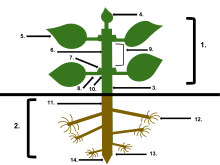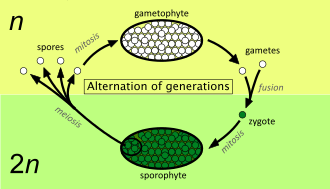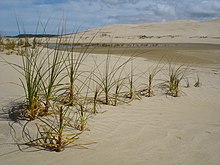Plant cells
Plant cells

Plant cells have distinctive features that other eukaryotic cells (such as those of animals) lack. These include the large water-filled central vacuole, chloroplasts, and the strong flexible cell wall, which is outside the cell membrane. Chloroplasts are derived from what was once a symbiosis of a non-photosynthetic cell and photosynthetic cyanobacteria. The cell wall, made mostly of cellulose, allows plant cells to swell up with water without bursting. The vacuole allows the cell to change in size while the amount of cytoplasm stays the same.[54]
Plant structure

Most plants are multicellular. Plant cells differentiate into multiple cell types, forming tissues such as the vascular tissue with specialized xylem and phloem of leaf veins and stems, and organs with different physiological functions such as roots to absorb water and minerals, stems for support and to transport water and synthesised molecules, leaves for photosynthesis, and flowers for reproduction.[55]
Photosynthesis
Plants photosynthesize, manufacturing food molecules (sugars) using energy obtained from light. Plant cells contain chlorophylls inside their chloroplasts, which are green pigments that are used to capture light energy. The end-to-end chemical equation for photosynthesis is:[56]
This causes plants to release oxygen into the atmosphere. Green plants provide a substantial proportion of the world's molecular oxygen, alongside the contributions from photosynthetic algae and cyanobacteria.[57][58][59]
Growth and repair
Growth is determined by the interaction of a plant's genome with its physical and biotic environment.[60] Factors of the physical or abiotic environment include temperature, water, light, carbon dioxide, and nutrients in the soil.[61] Biotic factors that affect plant growth include crowding, grazing, beneficial symbiotic bacteria and fungi, and attacks by insects or plant diseases.[62]
Frost and dehydration can damage or kill plants. Some plants have antifreeze proteins, heat-shock proteins and sugars in their cytoplasm that enable them to tolerate these stresses.[63] Plants are continuously exposed to a range of physical and biotic stresses which cause DNA damage. Plants are able to tolerate and repair much of this damage.[64]
Reproduction
Plants reproduce to generate offspring, whether sexually, involving gametes, or asexually, involving ordinary growth. Many plants use both mechanisms.[65]
Sexual

When reproducing sexually, plants have complex lifecycles involving alternation of generations. One generation, the sporophyte, which is diploid (with 2 sets of chromosomes), gives rise to the next generation, the gametophyte, which is haploid (with one set of chromosomes). Some plants also reproduce asexually via spores. In some non-flowering plants such as mosses, the sexual gametophyte forms most of the visible plant.[66] In seed plants (gymnosperms and flowering plants), the sporophyte forms most of the visible plant, and the gametophyte is very small. Flowering plants reproduce sexually using flowers, which contain male and female parts: these may be within the same (hermaphrodite) flower, on different flowers on the same plant, or on different plants. The pollen produces male gametes that enter the ovule to fertilize the egg cell of the female gametophyte. Fertilization takes place within the carpels or ovaries, which develop into fruits that contain seeds. Fruits may be dispersed whole, or they may split open and the seeds dispersed individually.[67]
Asexual

Plants reproduce asexually by growing any of a wide variety of structures capable of growing into new plants. At the simplest, plants such as mosses or liverworts may be broken into pieces, each of which may regrow into whole plants. The propagation of flowering plants by cuttings is a similar process. Structures such as runners enable plants to grow to cover an area, forming a clone. Many plants grow food storage structures such as tubers or bulbs which may each develop into a new plant.[68]
Some non-flowering plants, such as many liverworts, mosses and some clubmosses, along with a few flowering plants, grow small clumps of cells called gemmae which can detach and grow.[69][70]
Disease resistance
Plants use pattern-recognition receptors to recognize pathogens such as bacteria that cause plant diseases. This recognition triggers a protective response. The first such plant receptors were identified in rice[71] and in Arabidopsis thaliana.[72]
Genomics
Plants have some of the largest genomes among all organisms.[73] The largest plant genome (in terms of gene number) is that of wheat (Triticum aestivum), predicted to encode ≈94,000 genes[74] and thus almost 5 times as many as the human genome. The first plant genome sequenced was that of Arabidopsis thaliana which encodes about 25,500 genes.[75] In terms of sheer DNA sequence, the smallest published genome is that of the carnivorous bladderwort (Utricularia gibba) at 82 Mb (although it still encodes 28,500 genes)[76] while the largest, from the Norway spruce (Picea abies), extends over 19.6 Gb (encoding about 28,300 genes).[77]
![{\displaystyle {\ce {6CO2{}+6H2O{}->[{\text{light}}]C6H12O6{}+6O2{}}}}](https://wikimedia.org/api/rest_v1/media/math/render/svg/100302228047a00799cc68db892940dd5e3adc9e)
Comments
Post a Comment